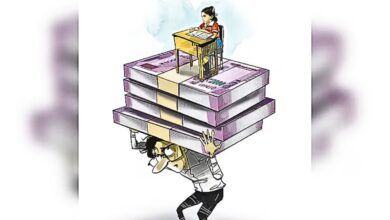India has a workforce but no work

Finding jobs and searching for a stable source of income is one of the biggest challenges people around the world have been facing ever since the coronavirus pandemic struck our so-called pre-pandemic normal lives. One of the biggest components of conversations about the effects of the pandemic and subsequent lockdowns lies in chunks about salary cuts, layoffs and worker union strikes. The impact of the disastrous situation has been worse on blue-collar jobs and the informal sector which employs the majority of the workforce in India. The last year has seen several families struggling to survive and feed on. Men and women were forced to consume bread and butter by depending on their lifetime savings, leaving many with meagre or no source of income.
In 2020, the median age of the Indian population stood at 28.4. The median age is nothing but the demographic midpoint- the age that divides the population of a country into two equal halves. On analysis from a third-person perspective, one might say that India’s population is fairly young ensuring that the country has a productive workforce. Well, that’s true but the harder part of the problem is that there is no work for the potential workforce. The expectations and reality do not match, especially when we talk about quality education and job opportunities.
Data under study- Lokniti CSDS KAS conducted the Youth Study 2016 among 6,122 young people aged between 15 to 34 during April to May 2016. The study was done across 19 Indian states. Another survey is the NES pre-poll 2019 in the month of March 2019 among 10,010 people aged above 18. It was conducted by Lokniti CSDS across 19 States in India. The NES post-poll 2019 was also conducted by the same organization from April to May 2019 across 26 states surveying 24,235 people aged 18 plus.
Analysis:
According to the youth study 2016, as much as 19 % or one-fifth of the Indian youth feels that lack of jobs is the biggest and the topmost concern of the country. The NES pre-poll survey conducted three years later in 2019 draws the same conclusion but in bigger numbers. The higher proportion of as many as one fourth or 25% of the young Indian population believed that while voting in the Lok Sabha elections, jobs and employment is the most important and crucial topic of concern. Out of this 25% of the respondents, the highest proportion was in the Northern parts of the country (34%) followed by the central regions (29%). It can also be concluded that the majority comprised of mostly Hindi speaking States. The proportion in the south stood at a mere 16%. Digging deeper into the geography of respondents, we find out that the pack was led by Delhi at 50% followed by Telangana, Haryana and Punjab at 40%, 39% and 36% respectively.
The NES pre-poll 2019 highlighted two more important problems around this issue of reduction in the number of jobs available in the country. One of the survey questions asked the respondents whether the job opportunities had fallen or risen during the last five years rule of the prime minister Narendra Modi led NDA government. To this 45% of the respondents answered that the employment opportunities had decreased while 28% claimed the opposite.
The other controversial question in the survey was that if it had become more difficult or less difficult to find new jobs during the last three to four years. As many as 49 % of the respondents answered that it had become even more difficult to fetch jobs while 21% of respondents believed that it was less difficult and another 21% believed that the statistics remained the same.
To ascertain the depth and centricity of the issue you may consider the statistics which claim that the picture is quite similar across all Indian villages, towns and cities having a percentage of 49%, 49%, and 51% of the total people highlighting this issue. Thus, it won’t be wrong to say that India is in a dismal state of employment with the covid-19 pandemic and the lockdown adding on to the further stress in the sector.
The youth study 2016 shows that almost 9 in 10 or 85% of the respondents were worried about getting a job with half of them being “quite a lot worried” and one in four being “somewhat worried”. Out of the respondents who said that they were quite a lot worried, we could notice a prominent gap between their genders. There was an enormous gap of 10 percentage points between young men and young women. Interestingly, young men living in cities tend to be more worried about their jobs and upcoming job opportunities. There was also a considerable gap between urban youth and rural youth as well.
The analysis was also encouraged by responses to a similar question in the NES post-poll 2019 survey. The question I am talking about was- “how serious is the problem of joblessness for the people like you?” To this question, 25% or one-fourth of the respondents replied “somewhat serious” while as many as three-fifths or 62% replied it to be a “very serious problem”. Shocking, right? There is finally one problem the majority of our countrymen think as imperative. Finally.
When asked about their preferred domain of job, many people responded in the favour of a government job. More and more youngsters are preparing to take government exams although the job vacancies provided by the states remain nearly the same. The youth study 2016 survey asked the respondents to make a choice between a private job, a government job or being self-employed (that is by setting up their own profession or business). The conclusions were astounding with two people in every three respondents preferring government jobs over any other kind of source of income. People belonging from the rural regions and the middle class seemed to be more inclined towards government jobs. Only one in ten people preferred being employed in the private sector.
The youth study in 2016 reported that nearly 24% of respondents reported themselves under the category of students. Students who might soon stand in the lines and queues for fetching their dream job. In fact, if you think about it, while you’re reading this article, these students might be filling their application forms and submitting their proposals on a government job portal or on platforms like LinkedIn. Many of them getting rejected.
Conclusion:
The data clearly shows that the condition of India’s employment sector is not very healthy and the disproportionate young population requires much-needed support and attention. It is dismal when we have the potential workforce and human resource but not the resources needed for their upliftment or making use of their unexplored capabilities such as quality education and adequate training systems. It is quite dolorous to think of how many talented students and young men and women are unable to discover and realize their potential simply because they do not have the necessary opportunities in hand. The economy needs to create more jobs as more and more people stand in line to join the potential workforce category every year. Many students who are not able to find appropriate jobs have no other option but to continue their studies.
Experts and analysts project India’s median age to increase by nearly 10 years to 38 by the year 2050. This is the median age of many developed countries today.




